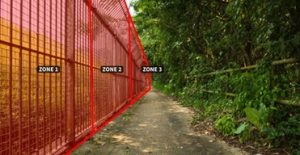
One of the greatest challenges for intruder detection systems is accurately detecting a threat that lies within a narrow external space. These spaces—including alleyways, sidewalks, and areas between buildings—are most often found around the property line of residential buildings, estates, farms, government buildings, critical infrastructures, and industrial sites. They are usually a result of two buildings very close to each other, vegetation growing near fence lines, or a building near a perimeter wall.
These areas make it difficult for analytics cameras to accurately detect; causing systems to falsely trigger or miss real threats altogether. However, according to Optex, 2D Lidar sensors have proven to be the most effective solution for this problem.
Effectively protecting these spaces are a difficult task for many systems, as they sometimes have an area of only a few feet and may have blocked fields of view. Multiple devices may need to be installed to ensure that these spaces are adequately protected, which is costly and inefficient.
In addition, because detection areas are so small, many sensors and camera analytics simply don’t have enough time to detect a target that moves quickly through the detection area. The most common approach to solving this problem is to increase the sensitivity of these devices. However, this can increase the number of false alarms that are triggered by wildlife or swaying vegetation.
Optex maintains that the solution to keeping these narrow spaces protected is Lidar technology. The company’s Redscan sensors utilise 2D Lidar technology to offer accurate detection in just 100 milliseconds. These devices can be mounted in a way that promises optimal protection and eliminates the need for multiple systems.
Redscan sensors can be mounted near a property’s perimeter line and programmed to generate a vertical or angled laser plane that detects anything trying to cross through. This technology both reinforces the security of fences and can create a virtual fence, with no vulnerable gaps, in an area that may not have one.
Multiple detection zones can be defined with an accuracy of up to 20x20cm (7.9×7.9in) and can be configured to alert to various criteria, such as target size, distance from the ground, and time of laser exposure.
The device’s intelligence allows it to only detect targets that meet the set criteria, alerting the system of genuine intrusions while ignoring false alarms triggered by moving wildlife or swaying vegetation. These alerts occur almost immediately and can allow for a timely security response—such as audio or lighting alerts, or the dispatching of police or security guards.
Redscan systems can be installed vertically to detect objects below and on either side, meaning that no additional sensors are needed to cover blind spots. The Redscan series is also integrated with all major VMS platforms, allowing for visual verification of a situation before initiating a response











